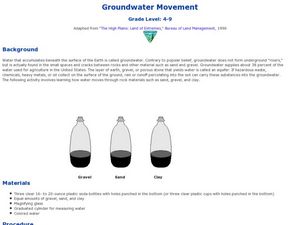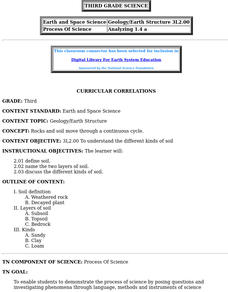Discovery Education
Future Fleet
Turn your pupils into engineers who are able to use scientific principals to design a ship. This long-term project expects pupils to understand concepts of density, buoyancy, displacement, and metacenter, and apply them to constructing a...
University of Georgia
Density and Texture of Soil
All soil is not created equal! A lab activity asks learners to collect and analyze soil. Specific calculations determine the amount of sand, silt, and clay in a sample and allow individuals to identify the soil texture.
DiscoverE
Seismic Shake-Up!
Shake your earthquake-resistant building prototype! Groups create structures using coffee stirrers and clay that can withstand seismic waves. They then test their structures against their own earthquakes.
Curated OER
Groundwater Movement
Students study groundwater movement beneath the surface of the Earth. In this agriculture activity, students experiment with how water moves through rock materials such as sand, gravel, and clay.
Curated OER
Curricular Correlations
An interesting lesson on different types of soils is here for you. In it, learners discuss what soil is, and consider three piles of soil - clay, sand, and loam. During the rest of the lesson, third graders discover all sorts of...
Curated OER
"What If The Earth Were Made Of Sand
High schoolers examine the most common characteristics of clay and sand, and to understand how the properties of these materials affect the erosion of the landscape and the formation of the many landforms. They explore clay and sand...
Curated OER
Volcano Lava Recipe--Experiment and Model
Young scholars build a volcano of clay around a container that is thin and tall. They experiment with two containers with different mixtures in each. Students write out their findings and use strong adjectives to describe how the two...
PBS
The Egg
The first stage in the butterfly's life cycle is the egg. Young entomologists discuss why different butterflies lay different eggs and what their eggs look like. Then they use the handouts to make a replica of one type of butterfly egg...
Perkins School for the Blind
Chromosome Models- Karyotyping
Create your own karyotypes with clay in a kinesthetic genome activity. This tactile experience was created for visually impaired pupils, but can be used for all hands-on learners who are beginning to study chromosomes. The preparation...
Curated OER
Animals in Art
Second graders demonstrate visual awareness by listing seven to nine types of animals shown in the artwork on the tour. They draw three types of textured lines or patterns shown in the tour artwork and model an imaginary animal using clay.
Curated OER
Sink or Float
Third graders sort objects into those they think will float and those that will sink and test their predictions. They experiment with clay molding it into shapes that float. They place pennies in them until they sink. They test other...
Curated OER
Pyramid Building: How to Use a Wedge
Students explore the simple machine of a wedge. For this wedge lesson, students test wedges on different materials including wax, soap, clay and foam. They learn how a wedge was used to build the ancient pyramid and modern day skyscrapers.
Curated OER
This Mine of Mine
Students explore natural resources by conducting a geology experiment in class. In this mineral mining lesson, students discuss the types of geological material that can be found when mining and the uses for these resources such as coal....
Curated OER
Dirt Cups
After a hard day examining and dissecting worms, why not put your feet up and snack on a few? Here is a really cute idea that can be used to celebrate Earth Day or to accent a thematic learning experience. Kids use clay pots, gummy...
Curated OER
Building a Clay Neuron
Students examine the anatomy of a neuron and its physiology. In this neuron lesson students build a representative model of a biological structure.
Curated OER
Building a Clay Neuron
Middle schoolers investigate and then build neurons in this lesson. They are examined as key parts of the brain and nervous system and seen as different from normal cells.
GNS Science
Think like a Geologist: 1
How well do pupils play the role of geologist? Test their abilities in the first installment of a two-part series. Presented with a series of rock formation diagrams, learners write stories to match what they see in the diagrams. The...
Curated OER
Rock On And Carve Off
Sixth graders work in groups of four to create one subtractive relief bust out of clay. Team results are shared and discussed to analyze the degree of planning and skillful manipulation of materials necessary to complete a limestone bust.
Curated OER
Be Brain Smart
Students examine the function of the brain. Using the internet, they research facts of the brains of vertebrates. Using clay, they make three sculptures of brains of different vertebrates and use crayola colors to color it. To end the...
Curated OER
Delicate Place Card Holders
Learners use air-dry clay to create small sculptures such as place card holders for meals with guests. They form flower petals, leaves and create a small bouquet. Afterward, students paint their sculptures and write names on their place...
Curated OER
Healthy Lungs
Students investigate the lungs and the effects of smoking upon them. They conduct research with the help of using multiple resources. The information is used in order to create the context of models made from clay of healthy and diseased...
Pacific Science Center
Worlds in Comparison
Young astronomers follow a step-by-step procedure for dividing a lump of dough into parts, resulting in a scaled volume set of puny planets. Along with the printable directions is a template chart of planet names on which learners can...
NorthEast Ohio Geoscience Education Outreach
Investigation of Plate Boundaries
Demonstrate the movement of lithospheric plates due to convection in Earth's mantle. Learners then model the movements that occur along plate boundaries using colored clay.
American Chemical Society
Density: Sink and Float for Solids
Steal cubes sink, but steal ships float. Lesson explores the density of solids as well as the density of water in determining what will sink and what will float. A hands-on group activity helps pupils see that weight and volume are two...
Other popular searches
- Clay Animation
- Clay Sculpture
- Claymation
- Clay Projects
- Clay Art
- Ceramics, Clay
- Clay Relief Sculpture
- Clay Construction Techniques
- Air Dry Clay
- Clay Modeling
- Clay Pottery
- Clay Masks

























